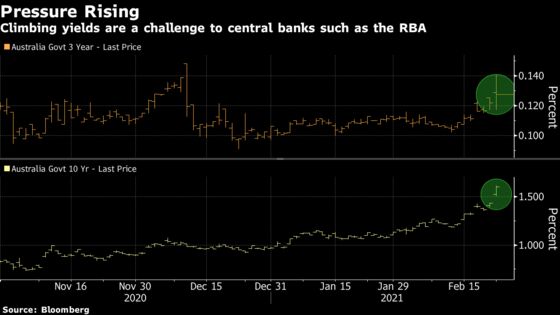Central Banks Are Already Facing Up to Threat of Rising Yields
RBA Defends Yield Target In Tussle With Traders Over Reflation
(Bloomberg) --
Reflation trades reached a fever pitch in Australia’s bond markets Monday in a burst of activity that will be hard for global policy makers to ignore.
Ten-year yields climbed the most since the height of the market dislocation in March 2020, while benchmark three-year yields inched further above the Reserve Bank of Australia’s 0.1% target. And this was after the RBA ended a two-month hiatus by stepping back into the market to purchase A$1 billion ($790 million) of the shorter-date debt.
The moves underscore the challenge to central banks as they strive to keep borrowing costs low for years to come while investors position for a more immediate return of inflation. Global vaccination programs and talk of another commodities supercycle have put Australia at the forefront of bets for rebounding growth and rising prices, making the RBA’s job particularly difficult. But it’s unlikely to be unique.
“Commodity prices are showing us a clear reflationary environment,” said Chris Rands, a portfolio manager at Nikko Asset Management in Sydney. “This is all about a global reflation story -- the flow of positive vaccine news is saying that ‘this isn’t crazy’.”

Expectations of more economic stimulus from the Biden administration and positive signs on containing Covid-19 are pushing rates higher globally, with the U.S. benchmark 10-year yield hitting a one-year high of 1.39% in Asia trading.
Australia’s three-year yield edged up to 0.13% Monday while the 10-year yield jumped 17 basis points to 1.6%, a level last seen on March 19. Excluding that day, it’s the highest 10-year yields have been since mid 2019. While the central bank has signaled that rates won’t begin rising for at least three years, money markets are now pricing in about a 30% chance of a hike by mid next year.
“It’s entirely reasonable for markets to start pricing in some risk of the RBA hiking rates,” said Prashant Newnaha, senior rates strategist at TD Securities in Singapore. “Markets are going to price in increasingly higher odds of the RBA having to pull the trigger before their three years are up.”
Global Dimension
Europe has also been caught up in the bonds selloff, with German 10-year yields, the region’s benchmark, climbing to the highest since mid 2020.
As the euro area’s yields track those on Treasuries higher, it faces an “undesirable tightening of monetary conditions,” according to Erik Nielsen, group chief economist at Unicredit SpA.
If they continue to climb in coming weeks, “it’ll leave the ECB no choice but to step up their purchases,” Nielsen wrote in an investor note Sunday. “I would be surprised if we don’t hear the first warning shots from key members within the next couple of weeks.”
Some Fed officials, though, are willing to accept the rising yields as a sign of optimism in the recovery. That’s the view of Federal Reserve Bank of New York President John Williams, as explained in an interview with CNBC Friday.
And Australia’s policy makers may yet disappoint rates traders preparing for a shift.
“The central banks fear that the bond market is jumping at what will be a transitory hike in inflation over the months ahead,” said Shane Oliver, chief economist at AMP Capital Investors Ltd. in Sydney. “They would rather look through any short term spike in inflation, and allow the recovery to use up spare capacity and generate higher wages growth before tightening -- and this may still be several years away.”
What Bloomberg Economics Says...
“Rising yields are likely to pressure further enlargement of the RBA’s recently-expanded bond purchase program, in an effort to limit further currency appreciation. There is also an increased risk of an earlier than planned announcement of a switch the yield target to the November 2024 bond..”
-- James McIntyre, economist
For the full note, click here.
Read More: Bond Traders Can See RBA Yield Curve Control’s Use By Date
Still, Australia’s success in containing Covid-19 has rapidly restored sentiment among households and businesses. That’s helped unemployment fall more than a percentage point from its pandemic peak of 7.5%, and rising property prices and cashed-up consumers are a potent mix for economic expansion.
This prompted Westpac Banking Corp. economist Bill Evans to last week raise his forecast for Australia’s 10-year yield to 1.9% by the end of this year, from 1.55% earlier.
In addition to purchases to control the three-year yield, the RBA is still conducting regular purchases of longer-dated bonds under quantitative easing, and bought another A$2 billion of them on Monday.
©2021 Bloomberg L.P.